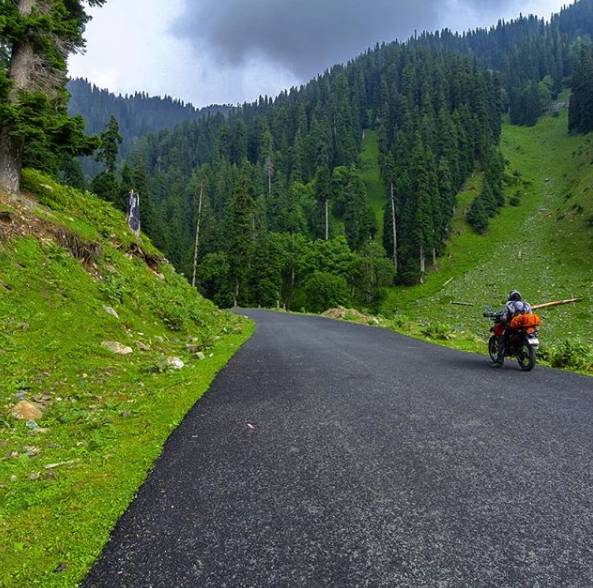Hello Steemit,
During July of 2018, I had the opportunity to ride my motorcycle to the region of Kashmir on the Indian side. For those unaware, the region of Kashmir has been the main bone of contention in the war between India and Pakistan that is being fought bitterly for the last 72 years.

Even for most of us Indians, and especially for folks like me who are from south of India, Kashmir is a paradise lost to violence. Whatever we know or hear about Kashmir valley is through news and online media. And the media, as it does throughout the world, mostly paints a very grim image of the valley.
So when we decide to explore Kashmir beyond the usual tourist circuit, it was a mix of excitement and apprehension. But I must say, most of our apprehensions were put to rest by the amazing and beautiful locals we met. I must say, everything is not normal. A lot of what the media reports are true and there is an ongoing conflict in the region. But we did, however, witness that most locals were trying to move on with their life despite the hardships and violence.
This is a photo story of our motorbike ride to Gurez valley, located 150 km north of Srinagar, the capital city of Jammu & Kashmir. The region of Gurez is located right at the Line of Control, an international border between India and Pakistan. The locals of this place are called Dards, who belongs to the erstwhile kingdom of Dardistan, now split between two warring countries. So it is not unusual for people here to have family members on the other side of the border, who they have not seen in years now and with no hope of seeing them ever.
The first thing that amazed was as we rode towards the region was the amazing landscape that welcomed us. It was truly a delight to witness something so beautiful.



We camped in the biggest town in the region, called Dawar. Here we met Bilal.

This is Bilal, our friend, guide companion in Gurez valley. All the beautiful photographs I have been able to document, of everyday life in the valley is thanks to Bilal's proactiveness.
His father owns a hotel opposite the Dal Bungalow where we were staying in Gurez. When we reached Gurez, it was late afternoon and we were famished. Even though his hotel did not serve food outside of their premises, he was more than happy to help us by bringing the food all the way to our hotel.
When we got to know that the next day we were heading towards the border and the last few villages on the Indian side in the valley, he expressed his desire to join us.
Initially, we were a bit reluctant, but within 10 mins he had changed and was ready. Seeing his enthusiasm, we took him along. And what a difference it made to our ride.
He took the role of the guide and showed us the villages. It was his idea to take us into the schools, get us introduced to the teachers and students there.
Whenever I tried to photograph people in the villages, they would shy away and try to close their faces. It was Bilal who would get off the bike, and have a conversation and make them feel comfortable in front of the camera.
The next day, we rode towards the border and to see the villages located closer to the border. Some of the visuals of local life from there.






We met some interesting folks too.

Meet Muzaffar Ahmed Khan, standing 2nd from the right holding the golden plaque in hand.
Considered the youngest innovator from Kashmir, this boy studying in the far-flung Tulail village in Gurez valley, his invention was put at display at innovation and entrepreneurship festival organized by NIF at the Rashtrapati Bhavan and appreciated by the President of India.
Muzaffar has designed the idea of a counting pen that counts the number of words as one writes with the pen. The idea of the pen struck him when he lost a few marks due to writing lesser words for an essay during one of his exams.
When we had gone to meet him at his house in his village, he was playing outside with the other boys. The moment we reached there, he ran inside the house, changed to the sherwani he is wearing in the picture and also put on a badge given to him at the conference in Delhi.
Although a shy boy, his eyes gleamed with enthusiasm when he explained to us about the pen.

The simple and humble abodes in the remote villages in Gurez valley.
Many remote villages in Gurez valley are still built with wooden logs ( available in abundance in the region). The only modern addition to this being the tin roof to deal with the heavy snowfall during winters.
Most houses typically consist of a large living room and kitchen. The living room also doubles up as a bedroom with many warm blankets being stacked in a corner.
Most of the house is carpeted to ensure warmth during freezing winters.
While the bigger towns in the valley have more concrete structures being built, the villages still have more traditional homes.
It's amazing how these traditional homes blend in so organically with the pristine landscape or the region.

The crazy roads that took us to this region.
It was one hell of a motorbike ride, not just in terms of broken roads and the adventure, but also the amazing group of people I met. They were warm, welcoming and held no bitterness about their home being broken into two for no fault of theirs.
My entire ride reminded me of a saying one of my old riding buddies always mentioned - every place we perceive as dangerous also happens to be someone' home.